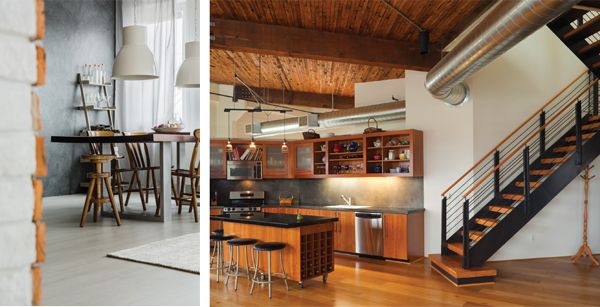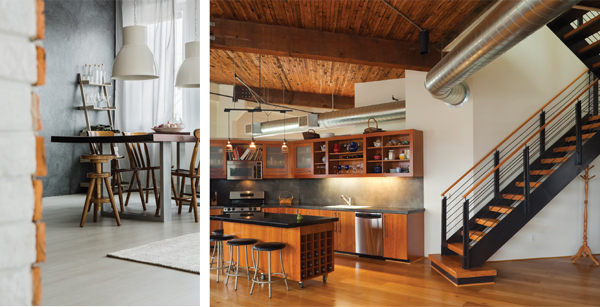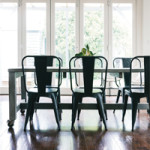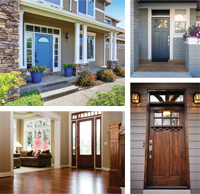Design, Defined | Industrial Style


Neutral palettes, high ceilings, exposed brick, concrete flooring, and open concept spaces are all signature aspects of industrial style. This factory-inspired look became increasingly popular in the late 2000s, when old industrial spaces started to be transformed into sophisticated lofts or offices. Rather than hide the past of these large, vacant buildings, their workaday elements were embraced and accentuated. Now, people are finding ways to bring aspects of this iconic design into their homes. No longer limited to commercial buildings in large cities, this chic style can be found in a small downtown apartment or a house in the suburbs.
The style has its roots in the Industrial Revolution, which took place in major cities from the 18th to 19th centuries. Massive buildings were erected and designed to facilitate manufacturing and streamlined production. Large windows lined the structures, allowing for natural light to flood the space. Open floor plans were required in order to sufficiently house the machinery, people, and processes. Concrete and steel came into the picture in the early 20th century, which allowed for even bigger structures. But as more land became needed to support these larger factories, construction moved away from the cities and metropolitan areas, leaving warehouses empty and abandoned. These spaces eventually became prime real estate for residential areas, restaurants, offices and more. Now, many developers are actually reproducing the historic factory style in their new construction — everything from apartments and condominiums to coffee shops and even wedding venues.
Industrial architectural style is all about simplicity, functionality and space. The motto “less is more” is truly perfect for this concept. Open floor plans with large windows to let in natural light are key aspects. You will usually see high, exposed ceilings and bare brick walls. Concrete or wood floors are also typical, and furniture and appliances will be composed of “raw” materials such as wood, metals, and leather. You really won’t see a ton of decor or colors in this look. Instead, the building or room itself and the style of furniture are what really sets the mood.
 The simplicity of the look means that this particular design style can be a relatively affordable one to achieve. Beams and water and ventilation pipes can be left completely untouched and don’t need to be covered by plaster and paint. It’s raw, edgy, and literally bares all as the foundation of the structure is put on display rather than hidden. Brick walls can be left in their natural state. Instead of interior walls, furniture can be used to define and break up a large area into separate, distinct spaces.
The simplicity of the look means that this particular design style can be a relatively affordable one to achieve. Beams and water and ventilation pipes can be left completely untouched and don’t need to be covered by plaster and paint. It’s raw, edgy, and literally bares all as the foundation of the structure is put on display rather than hidden. Brick walls can be left in their natural state. Instead of interior walls, furniture can be used to define and break up a large area into separate, distinct spaces.
For furnishings, you’ll want to stick to natural, earthy colors and materials. Blacks, browns, beiges, and especially grays all are great options when choosing a color palette. If your home includes any exposed brick, cement, or wood, then you already have a good foundation for figuring out your scheme. Use color sparingly—start with neutrals and rustic or faded hues, then slowly add in small doses of more saturated hues, such as fuchsia or indigo. Metal is a key component of the industrial look, particularly when combined with wood. Wood and metal tables or shelving are an easy way to add an industrial element. In the kitchen, stainless steel appliances, kitchen counter stools, and light fixtures fit the theme. Metal doors and stair railings provide a visual punch. A local salvage store is sure to have interesting finds that can either be incorporated into a piece of furniture, or displayed as an objet d’art.

If you love this style, but creating an entirely industrial-chic home is not on the menu, try incorporating a statement piece or two rather than attempting an overall look. Pairing a metal and reclaimed wood coffee table with a midcentury sofa could be the perfect pairing. Hang some Edison-style light bulbs or lanterns to achieve a vintage, historic feel. Install some floating shelves onto a wall with pipe brackets or lean a metal bookcase against an exposed brick wall. You can also use bold, bright artwork with graphics, hang a flag, or even paint a mural or symbol directly onto a wall to bring industrial details into your home. One of the things that makes industrial style so charming is its ability to mix and match so well with modern design.
Industrial style is all about finding the beauty in simplicity and functionality. It can be created in any sized space, in any type of location. All it takes is a little creativity and an appreciation for humble materials.
beiges, Blacks, browns, concrete flooring, earthy colors, exposed brick, factory-inspired look, functionality, grays, high ceilings, iconic design, Industrial Revolution, leather, metals, natural, Neutral palettes, open concept spaces, simplicity, sophisticated lofts, space, Wood






